 On a cold winter’s morning in Calgary, the alarm rings at 5:30am. It is dark outside. The dawn won’t come for another two hours. Not many people stir from their beds””except for the few passionate snowkiters like me.
On a cold winter’s morning in Calgary, the alarm rings at 5:30am. It is dark outside. The dawn won’t come for another two hours. Not many people stir from their beds””except for the few passionate snowkiters like me.
Setting a pot of coffee to brew, I warm up the car engine to face the sub-zero temperatures and circle back to my computer for one last check of the conditions. Refreshing the tabs on my browser, I revisit Mountains-Forecast and iKitesurf before checking the weather and avalanche report to size up any changes. With the wakefulness of a full dose of caffeine, I deliberately strap on my avalanche transceiver before moving any closer towards the door. The transceiver is the most critical safety device in avalanche terrain and must never be forgotten at home. My backpack includes one 11-meter single-skin kite (based on the wind forecast), a thermos of hot water and some energy-rich food; these items will be well-earned treats at the top of the mountain.
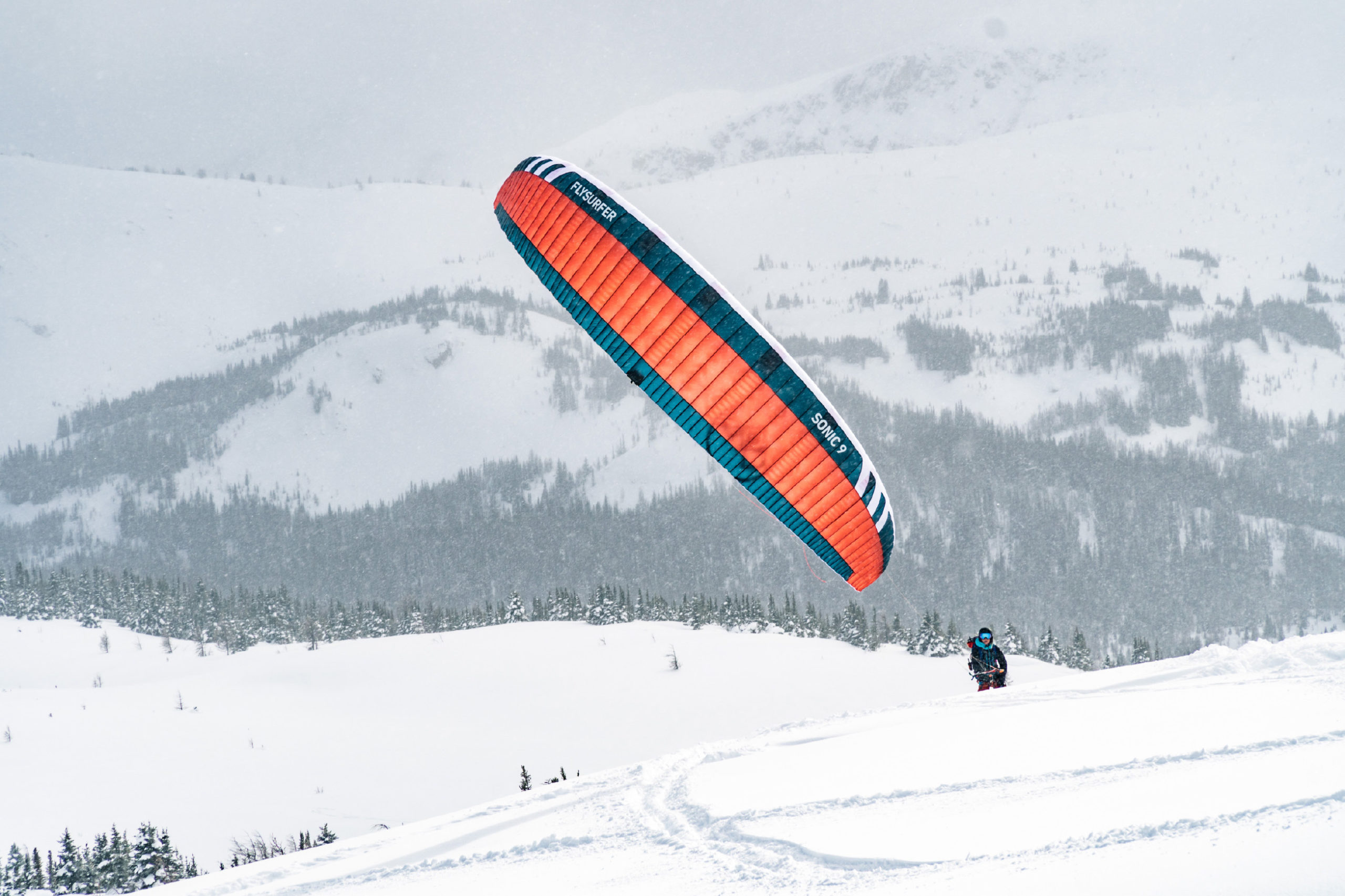
Sunshine Meadows is a great spot if you don’t mind skinning uphill for two and a half hours. The chairlift at Sunshine Village Ski Resort will get you most of the way, but you’ll still need backcountry gear to get the goods. // Photo Michal Hrk
The popular snowkiting backcountry spots in this part of Canada are in Banff National Park, Icefield Parkway and Jasper National Park, all within a 2 to 4-hour drive from Calgary. Most often, we choose less-frequented spots with familiar conditions where we have a better chance of scoring untracked powder, wind and diverse terrain. When we are in a more adventurous frame of mind, we travel to coveted virgin spots, hoping for favorable conditions, the privilege of exploration and the possibility of etching a new riding zone on the map. The snowkiter’s philosophy is to see what else is out there and survey the unknown.
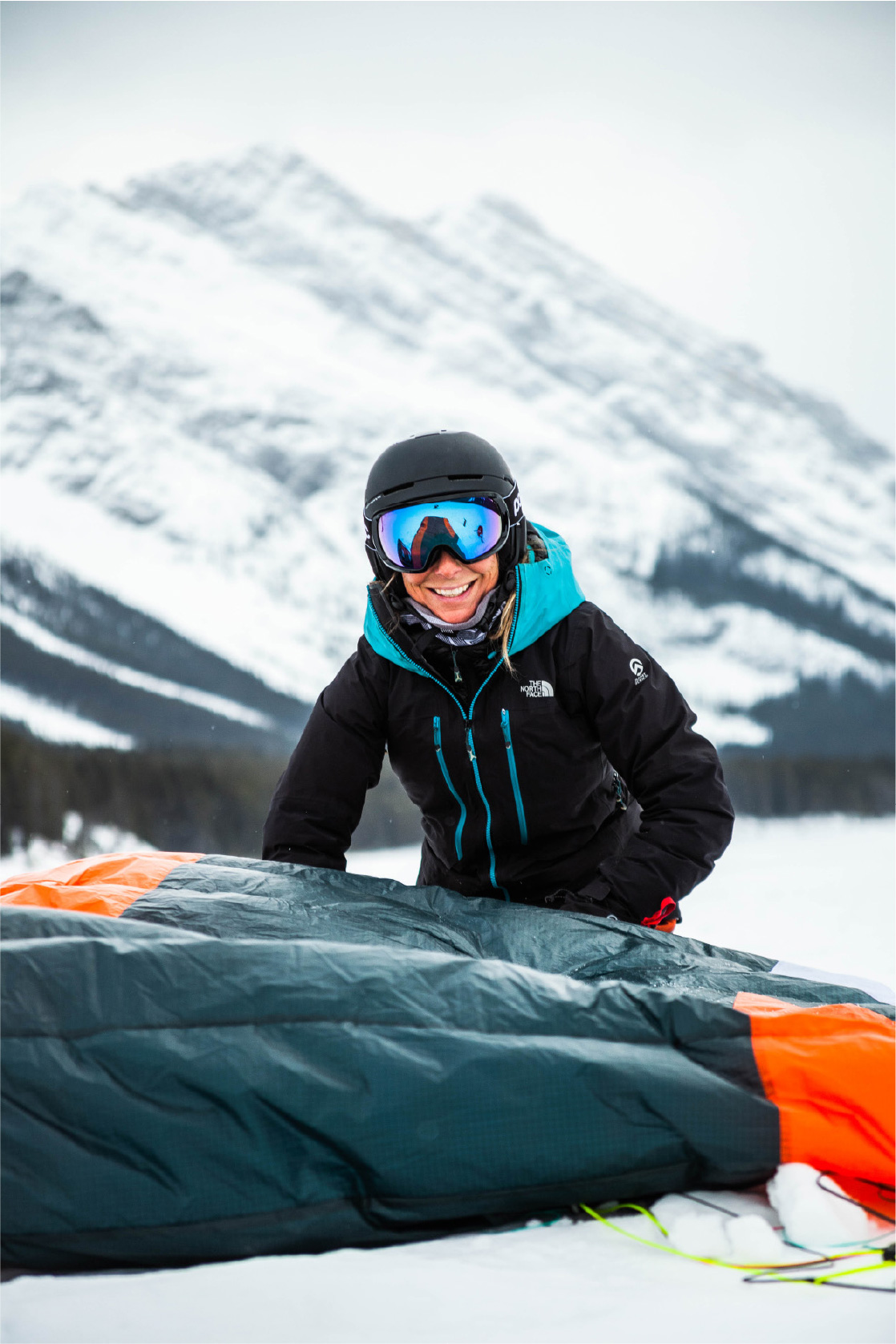
Marie-Eve rolls up her Sonic kite for the long ski home. // Photo Julia Barnes
The spirit of exploration is the main thread that pulls together the pioneers of the Canadian Rocky Mountains snowkiting family. My core group of backcountry friends has pushed me to explore the mountains in a different way. To name a few, the legendary Patrice Bance learned how to snowkite in the backcountry, having realized he could get across the terrain faster with a kite than with only just his skis. Patrice is probably one of the most important players in our crew, having discovered the bulk of the snowkite backcountry spots that we know to be operable in the Canadian Rockies. Another local hero and good friend, Jay Kilgannon, formerly a snowkite instructor at Rocky Mountains Snowkite, is by profession a firefighter. He used to teach outdoor survival classes with a formal organization in Alberta and is an incredible resource for winter camping and survival skills. Most notably, Jay has put some notes in the methodology for avalanche and crevasse rescue related to snowkiting. Ray Schmidt’s career with the National Parks puts him at the top of the list with his uncanny ability to name just about any nearby peak and its history. Ray leans towards solo adventures and is known for a successful 21-day snowkite expedition on the Northwest Territory’s Great Slave Lake, ultimately reaching the soaring granite cliffs of Thaidene Nene, Canada’s newest National Park. Finally, David Steele, the young blood of this snowkiting group, has energy like no one else, oftentimes skinning up or summiting mountains in record time. Dave is a professional rope access climber and offers a toolkit of essential skills for glacier travels. Interestingly enough, Dave lives by the one kite rule: he rides his 8m Flysurfer Peak in every condition.
In Europe, famed destinations like the Hardangervidda mountain plateau and the Varanger area in the Norwegian Arctic allow you to park your car, walk a few meters, set up your kite and begin snowkiting immediately in spectacularly large mountainous areas without much of a human-powered approach. Down in the US, the Big Horns in Wyoming and the town of Jackson, Montana, offer plenty of access to fun, hilly riding and vast terrain with fairly easy access. Here in Calgary, we have our easy-to-access kite spots on the Canadian prairies, which provide snowkiting access close to the city, but these spots offer primarily flat riding conditions. This is great for the less adventurous or those seeking to fit a quick snowkiting session into their work schedule. I frequently use these sites on weekdays to put in a quick and easy hour after a long day of work. It is not as thrilling as snowkiting in the mountains or glaciers, but it helps you build important kiting skills on flat ground, which makes you stronger in the mountains. On the flats, you can become intimately aware of every piece of gear (kite, skis, harness, etc.), the precise tuning of the kite and develop kite handling skills for all kinds of wind conditions.
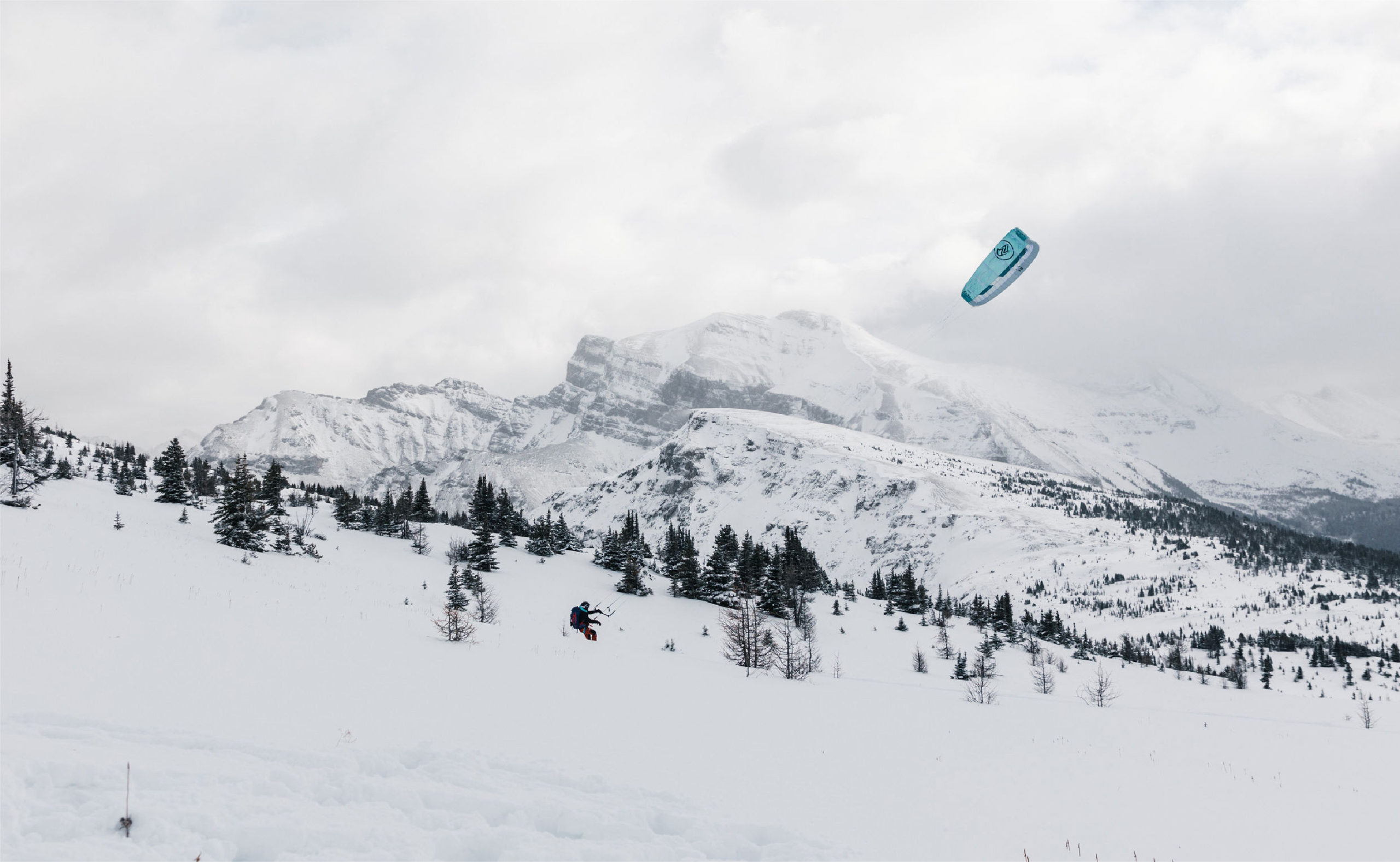
Marie-Eve scores an early November session with a surprising level of snowpack given the lack of snow in town. // Photo Michal Hrk
A major challenge for snowkiters in Western Canada is the difficult access to mountainous terrain and untracked powder. For those interested in exploring the Canadian Rockies, my favorite starting spots with easier access are Ptarmigan Lake and Sunshine Meadows. However, to access the best conditions, it requires significant knowledge of the area and planning to reach the desired big mountain riding areas. Complex weather systems and avalanche potential have to be tracked several days in advance, and you’ll have to check the availability of teammates; I have found that the ideal group consists of three to four skilled, enthusiastic and early-waking snowkiters.
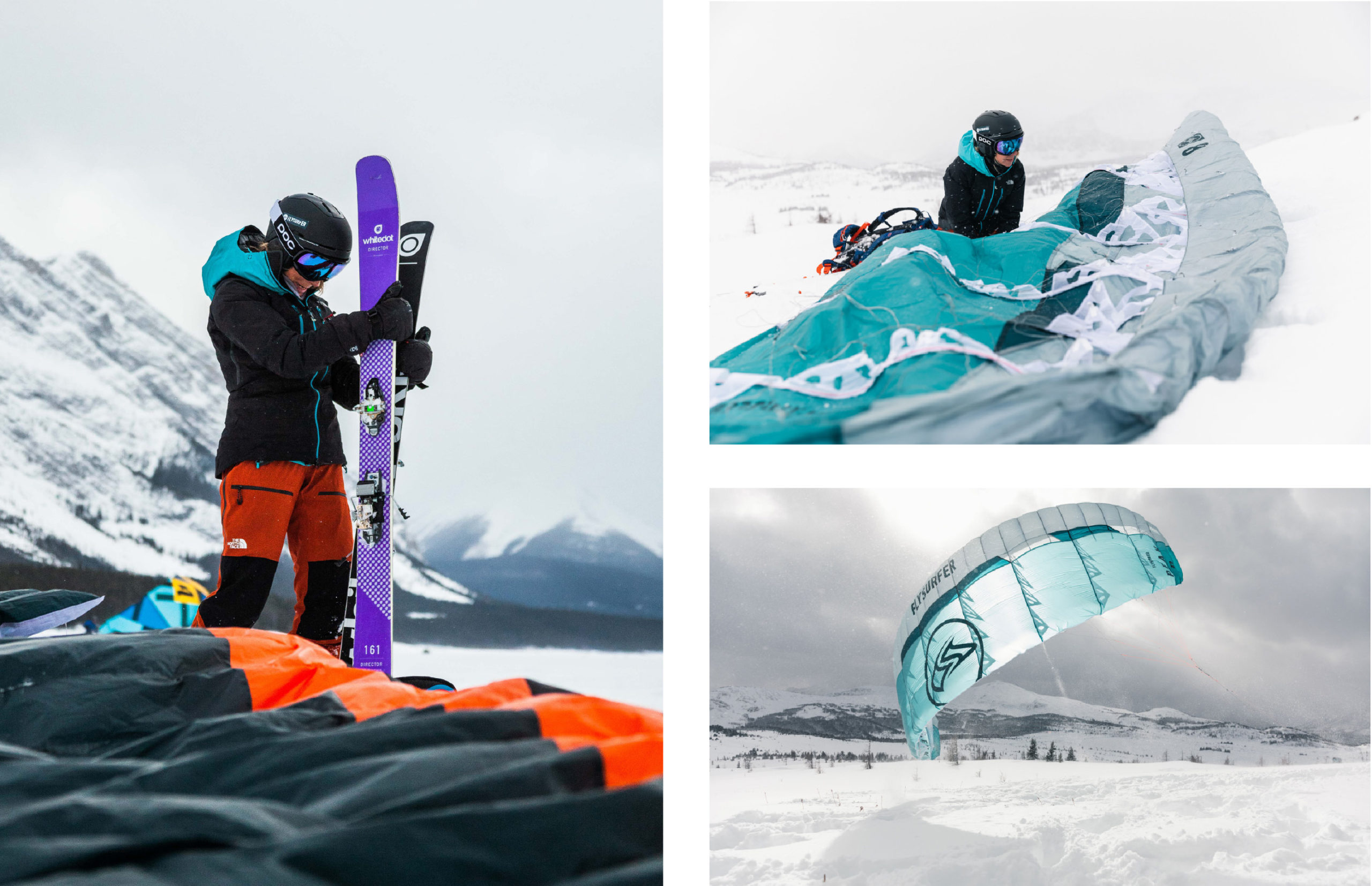
The best part of the experience is removing your climbing skins and getting down to snowkiting business. // Photo Julia Barnes TOP RIGHT: Marie-Eve lays out the Peak 5 which features a new single-skin design and cutout bridle tabs for decreased weight. // Photo Michal Hrk BOTTOM RIGHT: The Peak is known not only for its extremely light weight, but also for the B-Safe system that offers instant safety depower in crucial snowkiting situations. // Photo Michal Hrk
For me, a typical day starts before first light to accommodate the drive from Calgary, but sometimes I opt for a night drive followed by van camping in the mountains to avoid the morning commute. Because our mountains have deep forests, we have to hike above the treeline or stay in the open meadows to access clean wind. The ascent to open terrain above treeline requires skinning up through the alpine forest for several hours before getting to the potential snowkiting zone. Aside from the snowpack safety concerns, it is important to read the wind conditions and carefully pack the right kite. Many times, a 3-hour uphill ski trip has ended with no kiting due to unsuitable wind. With the invention of single-skin kites, I can stuff two different sizes into my backpack without adding much weight. With two kites, there’s a better chance of selecting just the right amount of power, and this is what makes snowkiting pure bliss. However, the duration of said bliss must be diligently managed on day trips, as it is best to ski down the mountain during daylight hours. Sometimes things can go wrong and you have to be prepared to descend with a headlamp. Skiing back to your car in the dark can be more complicated and time-consuming. It’s always important to be mindful of the exhaustion of a full-day trip. When you combine the initial climb with the time you spend exploring behind the kite, you will find no better workout””and this sometimes warrants extra care on your way down and an additional day to recuperate.
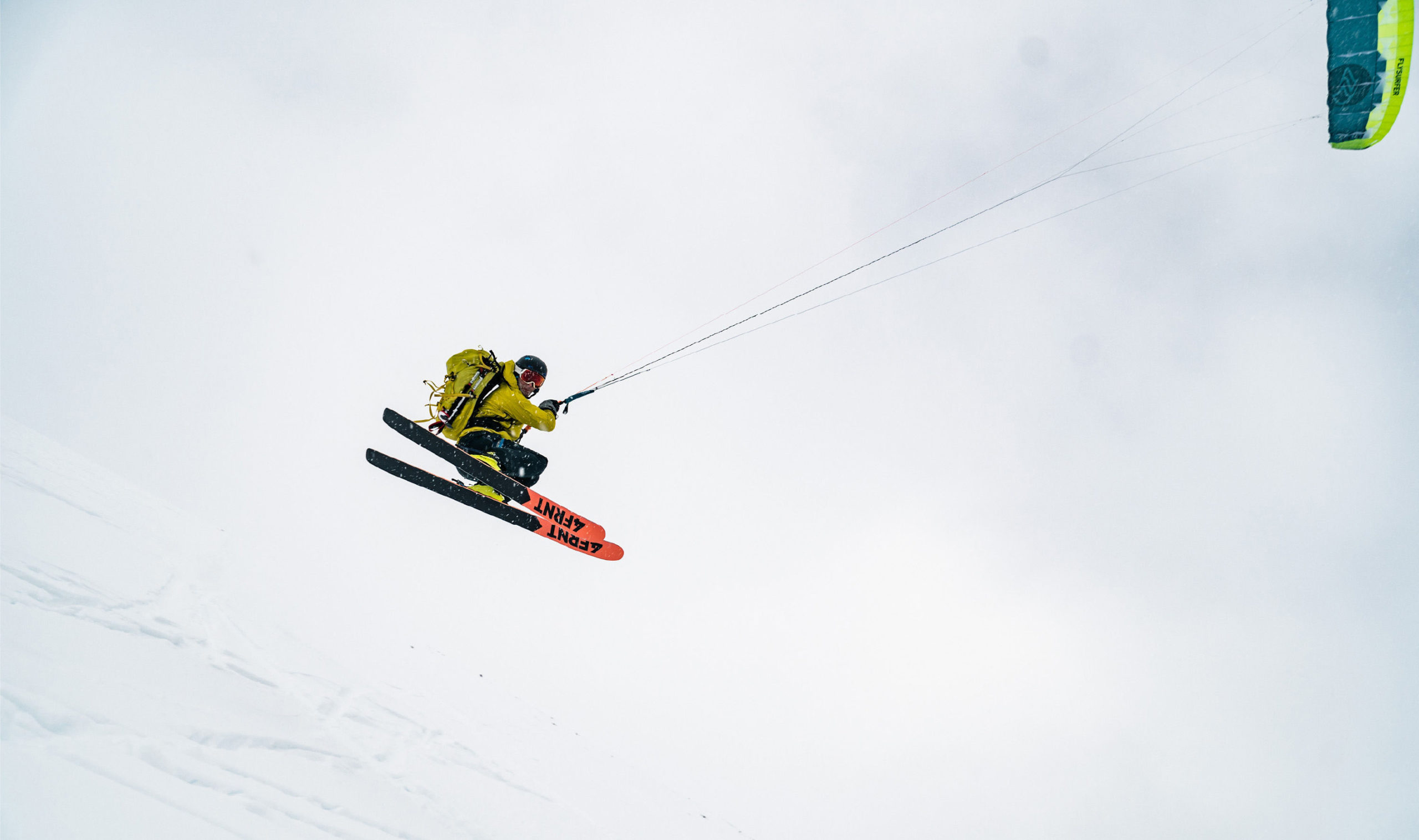
Ira Carson photographed at Sunshine Meadows. Ira is known for his affinity for exploration and stylish airs. // Photo Michal Hrk
When we want more snowkiting time, we plan a two or three-day trip with some winter camping thrown in. My backpack includes a tent, a -20ËšC sleeping bag, a cooking stove and some dry food for overnighters. For these kinds of trips, everything requires more planning. One of my favorite multi-day destinations is the Wapta Glacier, where you will find the backcountry Bow Hut on the summit. With access to a hut, you can stay overnight more comfortably, and with good wind conditions, you can access the Peyto Glacier and ascend Mount Rhonda or Mount Gordon. There’s a vast amount of terrain you can explore from this location, but it’s important to note that glaciers have their own unique challenges. For one, skiers can fall into crevasses hidden under snow, making it crucial to bring all the safety gear required for crevasse rescue and come prepared with the skills to use that gear. Any glacier kiting day always starts with a crevasse rescue refresher for our crew to ensure the entire team is informed and prepared.
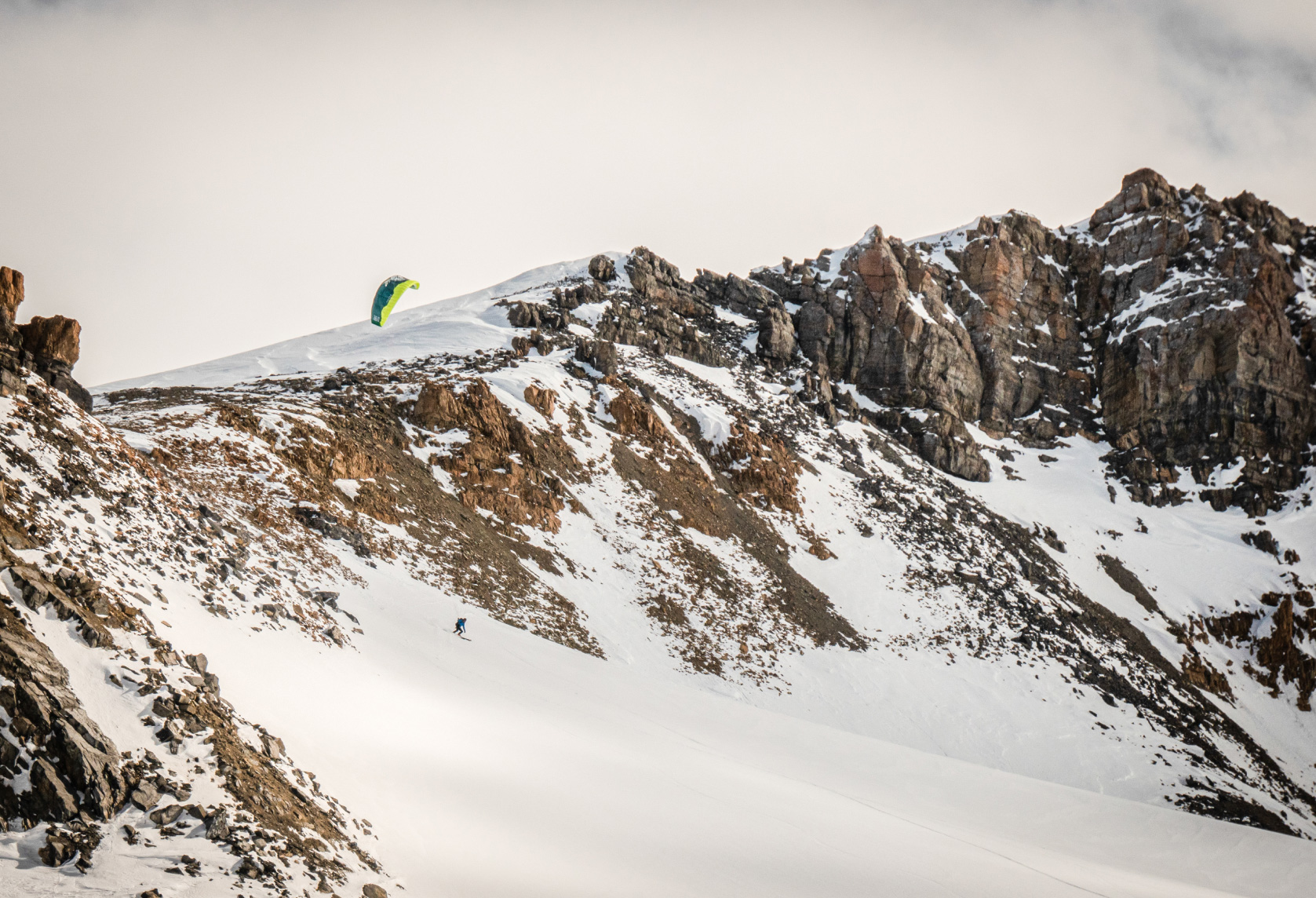
David Steele draws a clean line down Wapta Icefield. During this trip, group members Marie-Eve and Ray Schmidt scored some of the best conditions in the Canadian Rockies. // Photo Ray Schmidt
When the conditions are right, the kiting is magnificent with breathtaking views, and on a good day, we can cover over 50 miles of terrain. By backcountry standards, the kite is an incredibly efficient tool for exploration, but you have to be able to read the terrain and the constantly changing conditions at all times. Unique to our adventures on the Wapta Glacier, we always look forward to the evening congregations at the Bow Hut at the end of a long day, which is typically packed with ardent backcountry skiers who are eager to share their day’s stories. As snowkiting in the Canadian backcountry is still a niche sport, we get lots of questions from the skiers about choosing the right gear, the cost of equipment and how to learn snowkiting the right way.
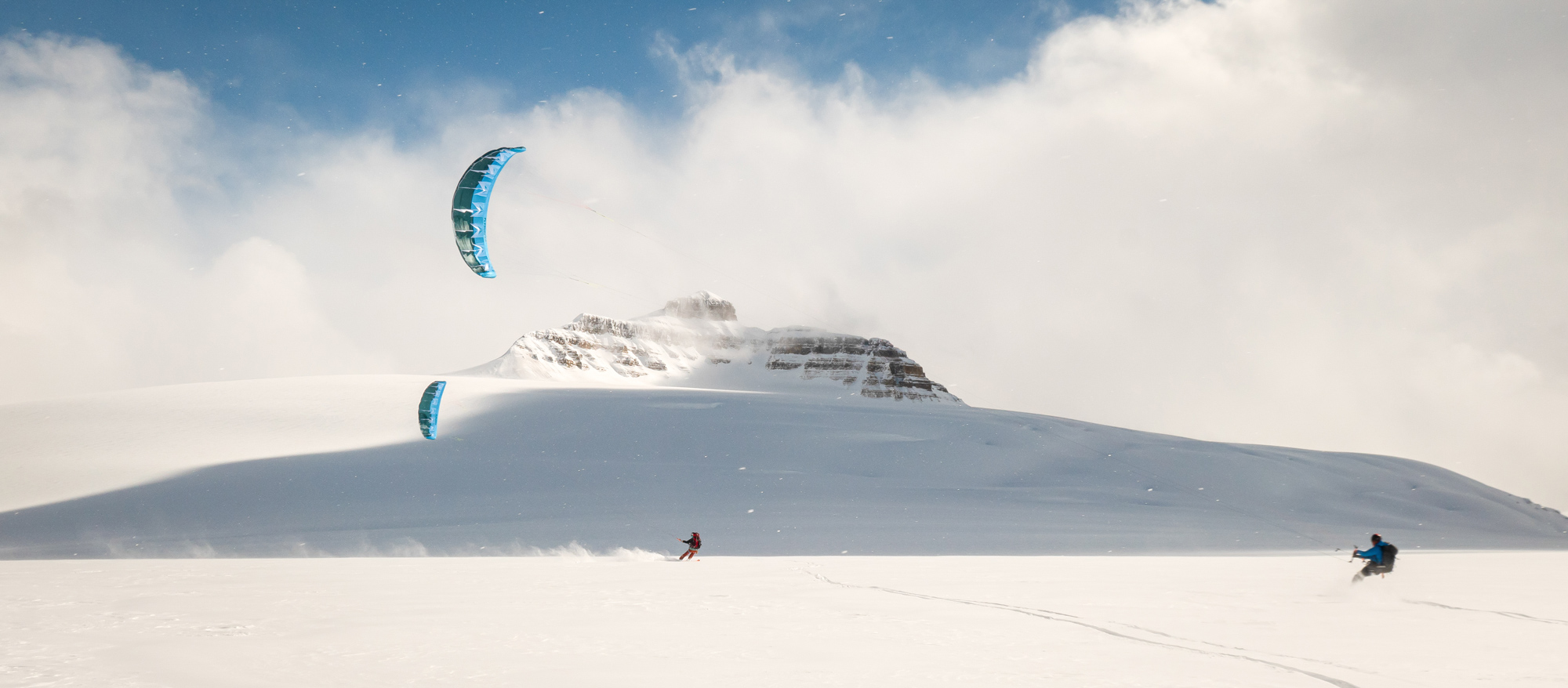
Charging across an undisclosed remote icefield with significant crevasse risks, some locations are better left off the record. // Photo Ray Schmidt
While deep backcountry snowkiting brings incredible rewards, it’s not something you can dive into headfirst. Aside from the initial equipment choices you make and basic kite handling skills you can develop on flat terrain, avalanche training is essential, and you’ll need to assemble the full toolkit for backcountry survival. Every snowkiter has to rely upon their backcountry partners for support and lifesaving decisions when things go wrong, so I highly recommend that you find a peer group with the same goals and develop this knowledge base together. There are backcountry programs that can help you learn these skills, and kite schools are a great place to find a guide that will familiarize you with new terrain. The backcountry community lives by its own code of independence, self-responsibility and pride in safety skills, but once you lay the groundwork, you will find the core practitioners of snowkiting in the Canadian Rockies to be an incredible resource for exploring the backcountry by kite.
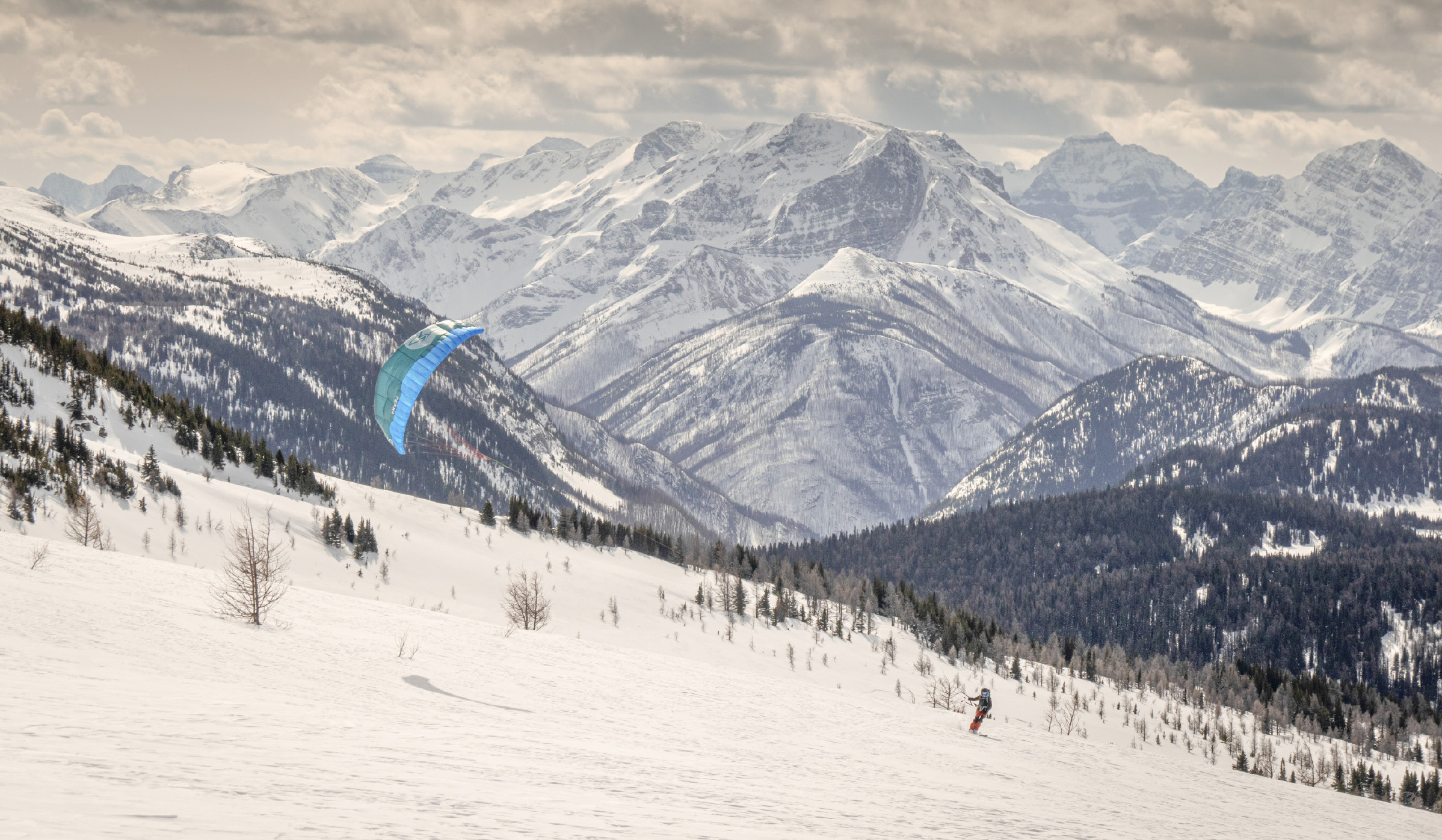
The conditions on Healy Pass can be fickle, but having scored two perfect days, Marie-Eve climbs with unbeatable scenery as her backdrop. // Photo Ray Schmidt
During the Calgary snowkiting season, the days are short, and the real adventures always run long. Whether you end your day in a snow-covered tent on top of the mountain or warm and safe back at home, kiting on snow will always test your skills, endurance and appetite for adventure. Writing about the big mountain or deep backcountry snowkiting experience always runs the risk of downplaying the natural barriers that exist between your parked car and the peak above. While addressing a general audience, it’s quite easy to over-simplify the skillset and necessary experience that serious snowkite athletes have assembled over years of backcountry outings. Yet, at the same time, it’s difficult to undersell the attraction of gliding across expansive terrain and exploring the unknown powder stash and clean lines that lay beyond that next ridge. The path into the backcountry is often long, technical and time-consuming, but reaching the top is almost always worth the dues paid along the way.

This article was featured in our winter 2022 issue, Vol. 18, No. 4. To read more, click here.

